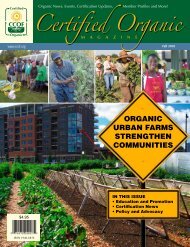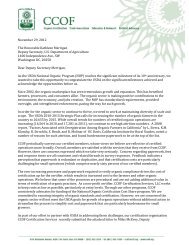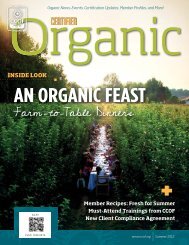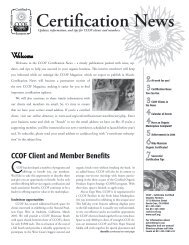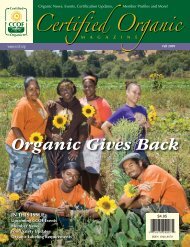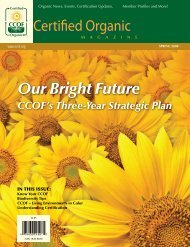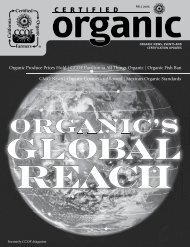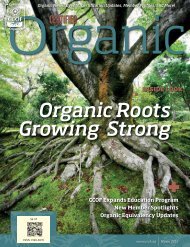Going Organic: Training New Growers - CCOF
Going Organic: Training New Growers - CCOF
Going Organic: Training New Growers - CCOF
You also want an ePaper? Increase the reach of your titles
YUMPU automatically turns print PDFs into web optimized ePapers that Google loves.
gmo news<br />
The GE Front<br />
Study Reveals Long-Term GM Contamination<br />
Startling new government research shows genetically<br />
modified (GM) crops are contaminating the British countryside<br />
for up to 15 years after they have been harvested. The<br />
findings cast doubt over the prospects of growing the GM<br />
crops in Britain.<br />
British ministers have stipulated that the crops should not<br />
be grown until rules are developed to enable them to “co-exist”<br />
with non-GM crops. But, this new study shows that this<br />
is virtually impossible.<br />
Published by the Royal Society, the study focused on five<br />
sites across England and Scotland where modified oilseed<br />
rape has been cultivated. Significant amounts of GM plants<br />
were found growing even after the sites had been returned to<br />
non-GM crops.<br />
The researchers found that nine years after a single modified<br />
crop, an average of two GM rape plants would grow in<br />
every square meter of an affected field. After 15 years, this<br />
came down to one plant per square meter – still enough to<br />
break the European Commission’s limits on permissible GM<br />
contamination.<br />
Rat Study Reveals Major GM Concerns<br />
Irina Ermakova, a leading scientist at the Institute of<br />
Higher Nervous Activity and Neurophysiology planned a<br />
simple experiment to see if eating genetically modified (GM)<br />
soy might influence offspring. She was amazed at the results<br />
of her study.<br />
Ermakova added GM soy flour (5-7 grams) to the diet of<br />
female rats. Other females were fed either non-GM soy or no<br />
soy at all. The experimental diet began two weeks before the<br />
rats conceived and continued through pregnancy and nursing.<br />
When the rats started giving birth, Ermakova noticed that<br />
some pups from GM-fed mothers were quite a bit smaller.<br />
After two weeks, 36% of them weighed less than 20 grams,<br />
compared to about 6% of the other groups.<br />
Another surprise came when the rats started dying. Within<br />
three weeks, 25 of the 45 (55.6%) rats from the GM soy<br />
group died, compared to only 3 of 33 (9%) from the non-<br />
GM soy group and 3 of 44 (6.8%) from the non-soy controls.<br />
The soy used in the study was Monsanto’s Roundup<br />
Ready variety. Its DNA has been manipulated to allow the<br />
soy plant to survive applications of Monsanto’s “Roundup”<br />
herbicide. About 85% of the soy grown in the United States<br />
is Roundup Ready. Because soy derivatives are found in the<br />
majority of processed foods sold in the United States, many<br />
Americans unknowingly eat ingredients derived from Roundup<br />
Ready soy every day. The FDA does not require any safety<br />
tests on GM foods.<br />
Jeffrey Smith, author of Seeds of Deception, presented<br />
Winter 2006 Certified <strong>Organic</strong><br />
Ermakova’s findings, with her permission, at the annual<br />
conference of the American Academy of Environmental Medicine<br />
(AAEM) in October 2005. In response, the AAEM board<br />
passed a resolution asking the U.S. National Institutes of<br />
Health to sponsor an immediate, independent follow up of<br />
the study. Dr. Jim Willoughly, the Academy’s president, said,<br />
“Genetically modified soy, corn, canola, and cottonseed oil<br />
are being consumed daily by a significant proportion of our<br />
population. We need rigorous, independent and long-term<br />
studies to evaluate if these foods put the population at risk.”<br />
GMO Activists March on Molokai<br />
About 20 protestors of genetically modified organisms<br />
(GMOs) on the island of Molokai, Hawaii, were allowed<br />
inside a company meeting of Monsanto’s Hawaii Research<br />
during November. The protestors left when they couldn’t get<br />
answers from executives. A majority of the estimated 150<br />
people in attendance were Monsanto employees who were<br />
GMO <strong>New</strong>s continued on page 18<br />
Meet the GMO Challenge<br />
Genetically modified crops<br />
are the biggest threat<br />
facing organic producers<br />
Receive a<br />
FREE<br />
sample<br />
issue<br />
The Non-GMO Report<br />
provides the information you need<br />
to respond to the GMO challenge<br />
and succeed in the fast-growing<br />
non-GMO market.<br />
The Non-GMO Report provides<br />
useful resources to help you:<br />
• Produce non-GMO crops<br />
and products<br />
• Prevent GMO contamination<br />
• Connect with buyers<br />
• Find non-GMO and organic seed<br />
• Stay up to date on GM food issues<br />
FREE with your subscription:<br />
The 2006 Non-GMO Sourcebook, a<br />
directory of non-GMO suppliers.<br />
Call 1-800-854-0586<br />
or 1-641-472-1491 or visit<br />
www.non-gmoreport.com




